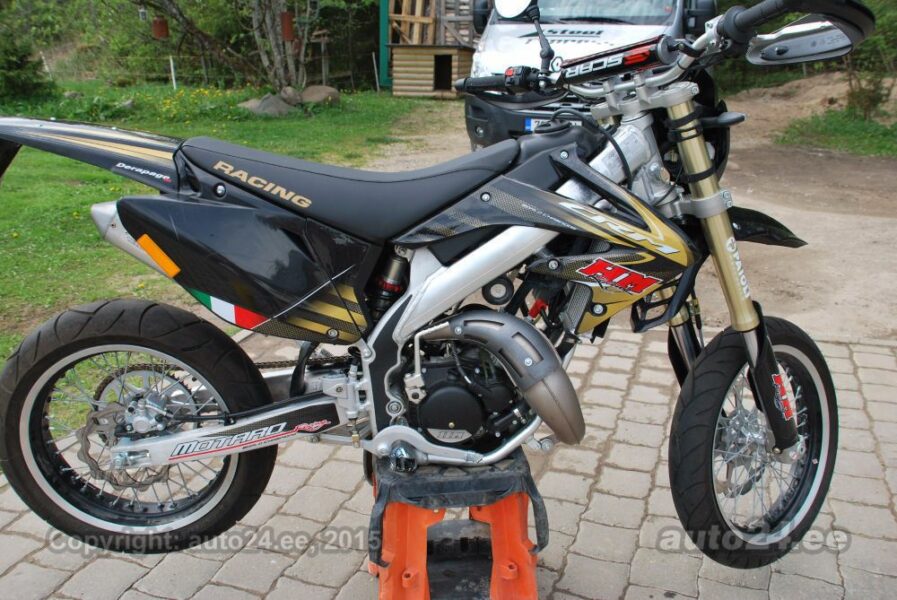
Kilometer PRVI: Prototipni HM CRM 50 Derapage Competition EK
(Iz Automagazina 04/2013)
text: Matevž Gribar, photo: Matevž Hribar, Tine Andrejašič
When I first turned the key in the ignition, nothing happened. “Should the appliances turn on?” I ask. And Tine, the master of electronic intelligence in electric vehicles, remembered that one more connector needed to be connected. “Here, now it works. You see, the battery is 99 percent charged.” Boris points to a small LED display where the fuel tank cap is and warns me to hit the clutch if the engine fails. This has never happened before, but care should be taken with cars at the prototype stage. Look, readers, what we are all ready to do for you! For once, you can be at least a little proud of having read about the first ride on an electric moped with a gearbox.
The idea is this: the frame remained unchanged, as did the suspension, wheels, headlights, seat (this was changed to the "test" HM only by the free will of Mr. Rados Simsic, who otherwise made the battery compartment). The motor housing (block) together with the internals, that is, the clutch and gearbox, also remain unchanged.
Cylinder, piston, connecting rod, exhaust system, carburetor, fuel tank - away! Instead, components with which the moped (based on the Italian HM supermoto machine) no longer needs fuel to move, but electricity. Sounds simple, right? This (ease of production or processing) was the main guide in finding a solution for Mr. Boris Pfeiffer, an innovator at Littoral who invented advertising railings for the needs of racing teams and breathed life into several other patents.
So: he presented one production line for a moped or a motorcycle, at the end of which the manufacturer decides whether the car will run on gasoline or electricity.
After driving the first hundred meters in a large parking lot, the question arose in my head, why do the clutch and gearbox. The electric motor does not idle (or its idle speed is constant), so the car can be in gear and started without using the clutch. And not only in first gear: also in second, third, more and more hesitant in fourth, fifth or sixth. An electric motor of the same power as the 50cc petrol has even more torque, and it is available right after "zero stroke". “The biggest difference is on the slopes. There, a car with a gearbox accelerates faster,” Boris is ready to answer. Impressions during and after the ride are very mixed.
First, there is no sound. Second, the engine's response is unnatural for our petrol-accustomed brains, but it's a matter of setting up a “ride on the wire” system (did you really think that “gas” is controlled by a cable?) And a computer. Thirdly: you can feel the weight and the (high) position of the batteries with a service life of 6.000 (!) Charges (at that time they still have 80% capacity). On the other hand, I am pleased with the torque immediately after adding gas. I believe that an electric drive can be very useful in the field where, with excellent torque, the drive will be almost inaudible. Interested in coverage? After about twenty minutes of testing on a flat surface, the battery gauge showed 87% charge.
The opinion of a "petrol" motorcyclist: Considering the carrying capacity and top speed of such a vehicle (45 km/h), three gears would be sufficient. The rest of the processing is interesting. Boris Pfeifer's task is to produce a mass-produced car that will be no more than a thousandth more expensive than gasoline, and to organize competition with cars with this and similar power plant, which require almost no maintenance. We have more to write about.
 Interview: Tine Andreyashich, www.rec-bms.com
Interview: Tine Andreyashich, www.rec-bms.com
What are the main components missing from a gasoline powered motorcycle?
An electric car consists of an electric motor, which is connected via a belt to the main shaft, an electric motor controller and an energy storage unit, that is, batteries. The controller is designed to control the engine, is connected to the throttle lever and transmits commands to the engine. An integral part is the battery management system, which controls each cell individually.
What can be controlled with a laptop?
The purpose of the scheme was primarily the ability to connect to a computer in case of service. After connection, the service technician shows all the parameters of the system, he can check if there has been an error since the last service, how many charges were, and what state the battery cells are in. The system records all states outside the limits and then displays them on the computer screen.
What is the main problem with redesigning an electric car today?
We have experience mainly with cars, and here the main problem is to properly match the engine and transmission, and the other problem is how to connect the whole system, which is designed to be connected via CAN bus. This battery management, vehicle electronics and electric motor are coordinated with each other. To get a useful and convenient vehicle, and so that the user does not have to screw into the garage every Sunday, roughly speaking.

 Interview: Tine Andreyashich, www.rec-bms.com
Interview: Tine Andreyashich, www.rec-bms.com